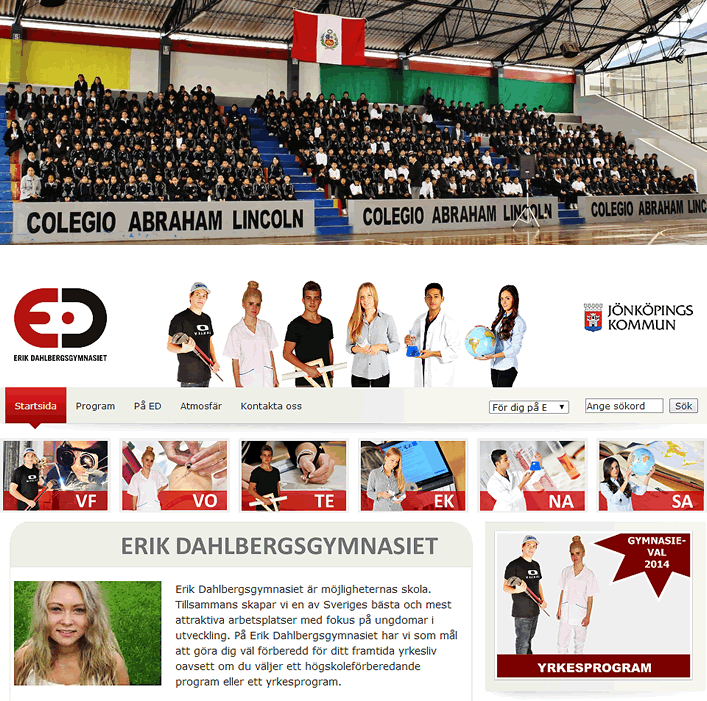
Images from the webs of the Peruvian North American Abraham Lincoln School and Erik Dahlbergsgymnasiet High School. A strategically placed click of the mouse will take you there!

Dispatches from Peru and Sweden
Offer Insights into Language Teaching.
Two Master of Arts In Teaching Grad Students
Travel To Lands Afar to Conclude their Internships.
By Freddie A. Bowles
Posted on Wednesday, April 30, 2014
Isela Mercado-Ulloa and Susan Moreno, Spanish language interns in the University of Arkansas Master of Arts in Teaching program (MAT), are finishing their internships in lands afar. This is the first year our program has offered an international placement.
Isela is hosted by the University School of Education in Jönköping, Sweden, but teaches at the Erik Dahlbergsgymnasiet, a municipal high school with approximately 1380 students. The school was founded in 1949 as a technical high school, but now has an expanded curriculum of six national high school programs.
Susan teaches at the Peruvian North American Abraham Lincoln School in Lima, Peru, founded in 1950 as a cooperative of 103 families in a house in the San Isidro district. The school is now located in La Molina and hosts over 1300 students from nursery to grade 11 and features three International Baccalaureate (IB) programs to “prepare our students to become active, creative, and responsible citizens.”
In addition to Isela and Susan from foreign language, MAT graduate students William Myers (English) and Erin Moody (Social Studies) teach with Isela in Jönköping, and Alaina Rainey (English) teaches with Susan in Lima.
All interns will return to Arkansas in early May to finish their programs and graduate on May 10.
Graduate students in the MAT program traditionally experience a year-long internship under the tutelage of experienced mentor teachers in the Northwest Arkansas area in two different school settings: a middle school, a junior high school, or a high school in either a suburban or rural setting. The placements may also be in a different school district each semester.
Faculty in the secondary education (SEED) MAT program determined in 2012 that internship placements should be expanded to include more diverse settings since many of our students were interviewing for job placements outside the local area, including urban and international locations. In 2013 a small group of students opted for placements in urban settings such as Little Rock and Dallas. One of my foreign language interns chose her placement at Sequoyah High School in Tahlequah, Oklahoma, a boarding school for students of American Indian heritage.
Isela and Susan argeed to write about their impressions and observations for our Multicultural Issues web. Here are their dispatches from afar.

Susan (left) and her fellow grad student Alaina Rainey pose amidst a culinary bonanza in Lima.
Susan’s notes from early April....
By Susan Moreno
Posted on Wednesday, April 30, 2014
I am now in my second week at Abraham Lincoln School in Peru. So far it has been a very interesting and exciting experience. I have not taught yet, but I am observing various teachers and their methods. What is unique about this internship is that I am placed in the Language B department, meaning English. I am not the “Miss” for Spanish but for English, so all my observations have been of teachers who teach English to these Spanish speakers.
I first want to say that the teachers here practice similar methods with a style of teaching that is very much like ours. The teachers add lots and lots of differentiation. They assist and provide an ample amount of examples when teaching grammar, and their strategies are spot-on to how we teach English Language Learners in the States. The only difference lies in the fact that these students have been learning English since they were in kindergarten.
Here the classrooms are made of concrete with lots of windows, so the room echoes a lot. The methods of integrating technology into the classrooms and teaching worldviews are very critical in this IB program school. This is similar to the universal viewpoints we employ when teaching Spanish through connections and culture.
The Drive to Be Better, To Know More
Many teachers I have observed effectively implement classroom management procedures. Also and to my surprise, many of the teachers here have their own classroom and only few travel from room to room. I say this is a surprise because it is different than how I remember when I went to a Chinese School here in Peru when I was 12. The methods have changed considerably and are very similar to our methods.
My current success centers on my enhanced awareness of the English language, but I'm also truly beginning to feel like a teacher. Feeling the pressure of not knowing enough about a concept or a grammar tense has inspired me to search for ways to teach myself and then reflect on how I can impart these key points to my students so that they understand. We need to put ourselves in our student's shoes and view the topics through their eyes. My reflections have raised some important questions. How, for example, should I teach all these different students the concept of present perfect? What activities will I need to implement to reach the highest levels of retention? What is the “best” way?”
I must admit that being out of my comfort zone and being removed from all that is familiar to me have seriously made me reflect and think critically, especially about my students and their special needs.
Being here as an intern makes me think about all those teachers who are not licensed to teach a certain subject. How are they learning the material so they can teach it effectively — or are they even trying to understand the subject themselves before they try to teach it? Are they just teaching from the book? My time in Peru, teaching a subject that I need to know in greater depth so that I can be better prepared to teach, has inspired me to “learn” and to keep learning, whether it is about the language I'll be teaching — Spanish — or the English language I'll use to support it!
I truly believe that all interns, no matter what subject they teach, should experience a classroom far from their comfort zone because it really opens your eyes to the challenges of being a professional educator. I have learned that it doesn’t matter where you are in the world or where you teach because, in the end, it’s all about who you are teaching: your students.

Isela embraces the wonders of Sweden.
Isela reports....
By Isela Mercado-Ulloa
Posted on Wednesday, April 30, 2014
At Erik Dahlbergsgymnasiet (ED), I met with the placement coordinator, Sören Frediksson, to talk about what the schedule would be like, get a tour of the school, and even get set up in my office! We also discussed how the Swedish school system works as well as how student-teachers are normally evaluated. It was very interesting to see the drastic differences between the Swedish and U.S. educational ideologies along with their implementation. The Swedes make distinctions between vocational and university track schools. However, they also value vocational and technical professions. I have been able to get a copy of the curriculum used for Spanish; however, it is written in Swedish. I will work to translate it to English with the help of Gunilla, my mentor.
The first week focused on class observations and getting to meet the students. It took three days to actually meet them all due to the scheduling. By the end of the week, my mentor, Gunilla Hallgren, and I were planning for the next week. I was able to start teaching by myself on Thursday, April 3. The other classes were mostly one-on-one introductions with students to gauge their interpersonal proficiency. During the off periods, I have been scheduling times to observe other teachers — many have asked that I co-teach or assist in their classes — and visit classes in other content areas such as English, French, and Native/Heritage Spanish.
My experiences during these first couple of weeks in Sweden have been amazing, even with its ups and downs. Yes, people speak English, which was a bit of a disappointment because it meant I couldn’t immerse myself completely in the language. However, the differences in culture, especially regarding the school system, are enough to compensate for being somewhat able to easily navigate my way through Sweden.
School attendance is only mandatory for students until ninth grade. At first, it is easy to think that students who continue are the ones who really want to be in school. Just like in the U.S., students place priorities on which courses matter more to them. Students in the high school, called the gymnasiet, are paid a stipend by the government if they continue school.
Block Schedules Are Designed
to Reflect a Collegiate Model.
The scheduling is radically different from what I’ve seen in the States. For example, at my new school, ED, students meet only twice a week on a block schedule — and they meet on different days and different times. The upper level class taught by my mentor meets only on Mondays for two hours forty-five minutes. Students from the surrounding schools come together in a "pool," which provides sufficient numbers to allow the class to be offered. To me, having class just once or twice a week is not optimal for learning another language.
My school is college track, so the schedule is designed to reflect what a college schedule in Sweden might be like. The school emphasizes student responsibility and accountability in several ways, including having no bell schedule, an open campus, and student scheduling conferences with parents and teachers.
Although it is slightly embarrassing to admit, I had a difficult time adjusting to planning lessons for one hour twenty minutes, the average length of my classes here. I was so used to planning for a forty-five minute classes that I could not even begin to wrap my head around where to start. Finally, I reached an epiphany: If students meet only twice a week, no matter if the times aren’t fixed, I can simply plan for a Part 1 and Part 2. The textbook used at ED for Spanish is written in Spanish and Swedish, so I have to rely heavily on the Spanish. The good thing is that the students at ED already have English as their second language, meaning that Spanish will be their third — and that is absolutely amazing!
To Compare and Contrast....
The pacing for levels of Spanish at ED are more similar to that of level A and level B in middle school. Hence, Spanish Level III in Sweden is more similar to a Spanish II course in the States, while a Level IV is more similar to a Spanish III. I can understand the reason behind this since students at ED are expected to continue taking their first language, Swedish, in addition to English as a Second Language classes. Gunilla has asked me to turn the Spanish study hour that meets on Tuesdays into an Enrichment class. She wants the students to have as much interaction with a heritage/native speaker as they can during these few weeks of my stay here.
My focus on interpersonal and interpretive modes of communication is ideal for my students. We practice impromptu conversations with random topics or questions. During the first five-to-ten minutes of class, I give students a “Pregunta del día” (question of the day) to practice speaking with their peers. I go from group to group, asking questions to help my students develop their speaking and listening skills.
I’ve discovered that students are very reluctant to participate in interpersonal communication in Spanish. I’ve come to the realization that students are very similar no matter where they are in the world. They are still scared to be criticized for saying or writing something wrong. It’s funny to work with three languages in a single classroom (Swedish, English, and Spanish), but it seems to work, perhaps because I have depended on modeling each activity and working alongside the students. I’m very excited about this rotation.


















